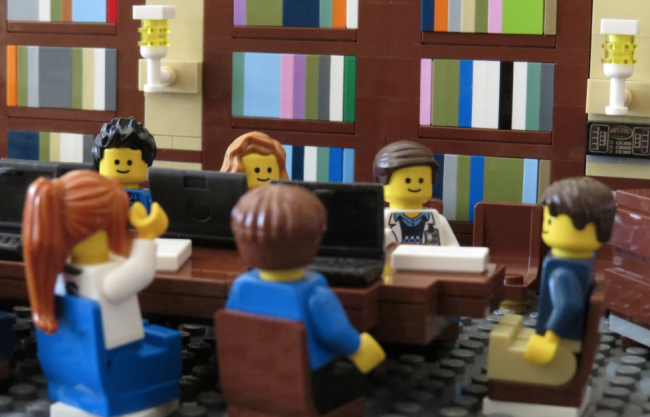You have /5 articles left.
Sign up for a free account or log in.

"Spending the weekend coming up with one comment, the grad student deflates as a classmate makes the point first."
Twitter/@LegoGradStudent
If a picture is worth a thousand words, a picture in Legos might just be worth 1,001 — at least to fans of the new social media accounts created by Lego Grad Student. A self-described “hollow head struggling to make it through a blocky world,” Lego Grad Student employs gallows humor and — you guessed it — Legos to portray the struggle of making it through graduate school intellectually, emotionally and financially intact. Cross-posted on Twitter, Instagram, Tumblr and Facebook, Lego Grad Student’s trials and tribulations have attracted quite a following since they first appeared in June.
That’s to the delight and surprise of their creator, an actual sixth-year (human) graduate student in the social sciences at a private university on the West Coast, who — for the moment — would like to remain anonymous. Why? As any follower knows, Lego Grad Student is on the job market. Plus, his creator said in an interview, the posts might not be so universal if it was revealed precisely what he was studying, and where.
It’s true that Lego Grad Student has fans across disciplines, who often use some variation of “devastatingly true” to describe his experiences. Indeed, his tableaux focus not on the intricacies of his research but rather on the human experience of graduate school: feelings of being on a treadmill to nowhere, being beaten to the intellectual punch by colleagues, using sophisticated avoidance techniques during a class discussion and the horror of seeing free food disappear before his eyes at departmental events.
Here are some examples:
Why Legos? Lego Grad Student (we’ll call his creator that, too) said he’s loved Legos since he was a child, when he spent hours upon hours playing with a five-gallon tub of the small, plastic blocks. Eventually, he said, he “very reluctantly” turned over the tub to his younger cousins — but the “training” came in handy again a few years ago. That’s when he bought the first of two large Lego sets that his inner 10-year-old “couldn't have even imagined.” He bought both the new tubs when his work hit a wall and he needed a break, he said, and “my mind kept drifting back to Legos as a form of unadulterated escape.”
In May of this year, after building out the second set, Lego Grad Student said he remembered that he preferred building his own creations, rather than Lego’s suggestions. The first thing he assembled was a small bathroom, just for fun.
Then, he said, “When I tried taking a picture, something about the image made me want to create a series of photos that would lead to it. I thought that a terrible meeting with an advisor would be a fun way to get there, and that it would give me more excuses to build other things with the 5,000-plus Lego pieces I had.”
And so an artist was born. Inspiration continues to come from personal experiences and second-hand stories, Lego Grad Student said, “exaggerated through my admittedly darker sense of humor.” Legos remain “just a nice way to spend an hour or two to decompress and to exercise my creative side.”
Lego Grad Student said he never meant for his posts to get any real attention, beyond that of his friends — but they have. His Twitter followers number some 1,100, with many retweets and expressions of commiseration. Most of his fans appear to be graduate students, but a number of faculty members like Lego Grad Student, as well.
Chelsea Catania, a Ph.D. candidate in materials science at the University of California at Santa Barbara, remarked on Twitter that Lego Grad Student’s posts are "depressingly accurate."
“I think these are pretty common experiences of grad students combined with some cognitive distortion, which makes it funny,” she said via email. Many of the themes presented are similar to those on other sites, such as Ph.D. Comics, she said, “just a little darker.”
Catania said her favorite Lego Grad Student post shows him running on a treadmill, where he’s “well-trained to feel exhausted while going nowhere.” That’s because she once saw an “inspirational” quote in a lab that read, "If at first you don't succeed, keep failing until someone gives you a Ph.D.” It was strangely motivational, she said, since graduate school “has given me a huge tolerance for failure, which may benefit me in the future — but when you're in the moment -- doesn't feel so great. Humor is a great way to get through it.”
Being able to recognize negative thoughts when you feel them also is an important lesson, she said, because some of the mental health issues plaguing graduate students — anxiety, imposter syndrome, depression — “aren’t openly discussed enough.” Those are thoughts and feelings that Lego Grad Student “nails,” she added.
Karen Kelsky, moderator of the blog The Professor Is In and a one-time tenured professor-turned academic career adviser, said Lego Grad Student "perfectly captures the angst and futility of the grad school experience and also its absurdity," or "the tiny, banal indignities that loom so large in ways that are incomprehensible to anyone outside the world." And the miniature, plastic scale of Legos in particular -- along with the "unchanging, plastered-on smile" of the grad student -- "convey this so brilliantly," she said.
Kelsky added, "I especially love the witty staging and film noir angles."
Lego Grad Student said he's gotten "such encouraging responses from both grad students and professors alike, and I am thankful for every single piece of support I get." He added, "I've always felt better during the more stressful moments of graduate school when I knew that I was not alone in feeling a certain way or having a particular experience. I hope that these posts, in their own absurd way, provide that sort of reassurance to others.”









